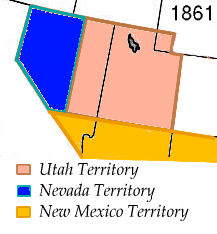Nevada Territory

Nevada Territory was a historic, organized territory of the United States from March 2, 1861 until October 31, 1864, when it became Nevada, the 36th state. Prior to its designation as a territory, the area was part of western Utah Territory and was known as Washoe, after the native Washoe people. Despite the silver wealth of Nevada, and the ever-increasing population of miners that came to exploit it, Nevada was not quite populous enough to warrant statehood, but the Union's need for silver and the generally anti-slavery bent of its people trumped the population problem and led to statehood.
Nevada gained most of its present boundaries in 1866, when eastern portions of the state (for example, Lincoln County) and the southern tip were moved from the territories of Utah and Arizona, respectively.
The exact location of the California-Nevada border, between Lake Tahoe and the intersection of the 35th parallel with the Colorado River, was contentious and was surveyed and re-surveyed well into the 20th century.[citation needed] Congress transferred some of the lands west of the Colorado River including Pah-Ute County, Arizona Territory to Nevada on May 5, 1866. This southern tip of Nevada was renamed Clark County and today contains the city of Las Vegas.
The territorial capital was moved from the provisional capital of Genoa to Carson City. James Warren Nye succeeded Isaac Roop, the first provisional territorial governor, and became the first and only territorial governor. The secretary of the territory was Orion Clemens, older brother of Samuel Clemens (Mark Twain).
